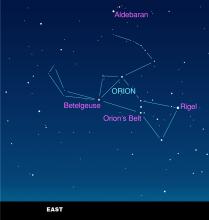Listen to today's episode of StarDate on the web the same day it airs in high-quality streaming audio without any extra ads or announcements. Choose a $8 one-month pass, or listen every day for a year for just $30.
You are here
Orion Nebula
One of the most remarkable sights in the night sky is M42, the Orion Nebula. It looks like a hazy patch of light in Orion’s Sword, which is to the right of his three-star belt in early evening. The nebula is one of the most-distant objects that’s visible to the eye alone – more than 1300 light-years away. It’s also one of the biggest – a couple of dozen light-years across.
What’s really remarkable, though, is the nebula’s identity. It’s a nursery that’s given birth to thousands of stars, with thousands more being born today. And all of that activity has taken place over just a few million years.
M42 contains huge clouds of gas and dust. Clumps of this material collapse to form stars. The most massive stars form a cluster known as the Trapezium. These stars are much bigger, brighter, and heavier than the Sun. They produce a lot of ultraviolet energy. It zaps the gas around them, making it glow.
If you could travel inside M42, you’d see hundreds or thousands of stars. Some would be too bright to look at directly, while others would look like dull embers. Ribbons and curtains of gas would surround you, glowing pink, green, or blue-white. Dark lanes and blobs would run through the background – dense clouds of dust where more stars are taking shape.
You’d also see some objects that look a bit like tadpoles – proplyds – the possible birthplaces of planets. We’ll have more about that tomorrow.
Script by Damond Benningfield





